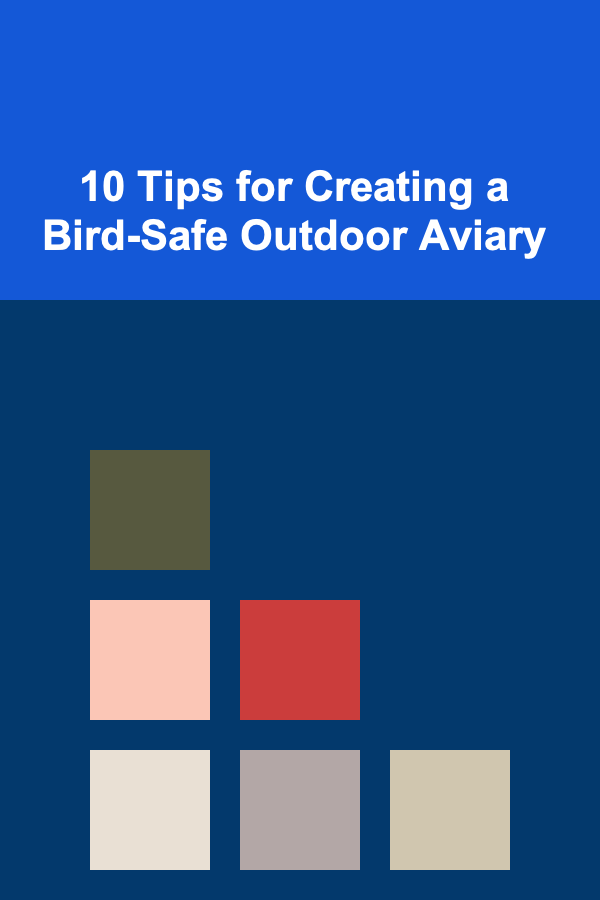
10 Tips for Creating a Bird-Safe Outdoor Aviary
ebook include PDF & Audio bundle (Micro Guide)
$12.99$9.99
Limited Time Offer! Order within the next:

Creating a bird-safe outdoor aviary is an exciting and rewarding project for bird lovers and enthusiasts. A well-designed aviary provides a safe and stimulating environment for birds, allowing them to stretch their wings, socialize, and exhibit natural behaviors. However, it's important to prioritize safety to ensure that the aviary doesn't pose any risks to the birds' well-being. Whether you're housing exotic species, domestic birds, or a mix of both, taking the necessary precautions will ensure that your feathered friends thrive in their new outdoor home.
In this article, we'll explore 10 essential tips for creating a bird-safe outdoor aviary. These guidelines will help you design a secure, comfortable, and enriching space that allows birds to enjoy the outdoors while minimizing potential dangers.
Choose the Right Location for Your Aviary
The first step in creating a bird-safe outdoor aviary is selecting an ideal location. The site should provide adequate protection from extreme weather conditions, predators, and other environmental hazards. Ideally, place the aviary in a shaded area to protect the birds from excessive heat, especially in hot climates. It should also have easy access to natural light for the birds to maintain their circadian rhythms and get the necessary Vitamin D.
When choosing the location, consider the following factors:
- Shade and Shelter: Birds need shade to avoid overheating, particularly in direct sunlight. Choose a spot with trees or a structure that provides natural shade. If this is not possible, you may need to install shade cloth or a roof to protect them from the sun.
- Protection from Strong Winds: Make sure the location isn't exposed to strong winds, which could damage the aviary and cause stress to the birds.
- Predator Safety: Select a site away from areas where predators like raccoons, cats, or hawks are common. This minimizes the chances of a predator attacking or entering the aviary.
Tips for Location:
- Avoid areas that are prone to flooding.
- Place the aviary where it won't be disturbed by human or animal traffic.
- Ensure the location is accessible for regular maintenance and cleaning.
Use Safe Materials for Construction
The materials you use to build the aviary are critical to the safety of the birds. When selecting materials, ensure that they are sturdy, non-toxic, and durable enough to withstand outdoor conditions.
Key Materials to Consider:
- Wire Mesh: The most common material used for aviary walls is wire mesh. Opt for a rust-resistant, galvanized steel or stainless steel mesh with small openings (1/2 inch or less) to prevent birds from escaping or predators from entering. Ensure that the mesh is securely fastened and won't sag or bend easily.
- Wooden Frames: If using wood for framing, choose untreated, non-toxic wood. Avoid using wood that may be prone to rot or pests, such as pine or cedar. Hardwoods like oak or maple are better choices for longevity and durability.
- Non-toxic Paints and Sealants: If you plan to paint or seal the aviary, make sure to use bird-safe, non-toxic paints and finishes. Many commercial paints contain chemicals that are harmful to birds, so opt for natural, safe alternatives.
- Perches and Nesting Boxes: Use natural wood for perches, ensuring they are safe for the birds to grip and don't cause injury. Make sure the perches are of varying thicknesses to provide natural foot exercises.
Material Safety Tips:
- Avoid using lead or other toxic materials in the construction of the aviary.
- Ensure the wire mesh is free of sharp edges that could harm the birds.
- Always check for any potential hazards, such as loose nails, screws, or other items that could pose a threat.
Create Secure Entrances and Exits
Entrances and exits are critical points in an aviary and should be designed to prevent escape or unwanted entry. Ensure that doors are secure, easy to operate, and bird-safe.
Key Features of Secure Entrances:
- Double Doors or Locking Mechanism: To minimize the risk of accidental escapes, consider using a double-door system. This involves having two doors, with a small space between them, to ensure that birds cannot escape when entering or exiting. The doors should have strong locking mechanisms to prevent them from being opened by curious birds or predators.
- Size of the Entrance: The entrance should be large enough for you to comfortably access the aviary for maintenance, feeding, and cleaning, but not so large that it poses a risk of escape. A size of around 3 feet by 3 feet is usually sufficient for human access.
- Door Design: Ensure that the doors are designed in a way that prevents birds from getting caught in them. Sliding doors or swing doors that open inward can help prevent accidental harm.
Entrance Tips:
- Make sure to have an area where you can safely close off the entrance to prevent the birds from flying out when you enter or exit.
- Check the door locks regularly to ensure they are secure.
Prevent Predators from Entering the Aviary
Predators, including birds of prey, raccoons, foxes, and domestic pets like cats or dogs, can pose significant threats to the safety of your birds. It is essential to design the aviary with these threats in mind and take measures to prevent predators from accessing the space.
Predator-Proofing Tips:
- Wire Mesh: Use small mesh openings (1/2 inch or less) to prevent predators from getting their paws or beaks through the wire.
- Bury the Bottom of the Aviary: To prevent digging animals like raccoons from entering, bury the bottom of the aviary wire mesh at least 12 inches underground. This will stop predators from tunneling under the fence.
- Cover the Aviary: To protect the birds from birds of prey, install a solid roof or a mesh roof that is strong enough to withstand the weight of predators. Ensure there are no gaps large enough for predators to swoop in.
- Secure the Base: Ensure that the base of the aviary is tightly sealed and that no gaps exist where predators can sneak in.
Provide Natural Enrichment and Perches
Birds are highly intelligent and curious creatures that require mental and physical stimulation. A bird-safe outdoor aviary should be designed to offer enrichment opportunities that encourage natural behaviors, such as flying, climbing, and foraging.
Enrichment Features:
- Natural Perches: Install a variety of natural perches made from untreated wood. The perches should be of varying thickness to promote foot health and provide birds with different levels of difficulty when they perch.
- Climbing Structures: Add climbing ropes or branches to encourage birds to explore and exercise their muscles. Make sure that these structures are secure and can support the birds' weight.
- Hiding Spots: Birds enjoy having spaces to hide and rest in private. Providing natural branches or foliage that they can retreat into can help them feel secure and reduce stress.
- Foraging Opportunities: Consider adding foraging toys or hideaways where you can place food, encouraging the birds to search for their meals. This provides mental stimulation and mimics their natural behaviors in the wild.
Ensure Proper Ventilation
Ventilation is essential for the well-being of your birds. Proper airflow helps prevent the buildup of ammonia from droppings and ensures that the air inside the aviary remains fresh and healthy.
Ventilation Tips:
- Mesh Walls: Mesh walls provide excellent airflow while keeping the birds secure. Make sure the mesh is not too tightly woven to restrict airflow.
- Ventilation Gaps: Incorporate gaps or vents at the top of the aviary for hot air to escape and ensure a constant flow of fresh air.
- Avoid Drafts: While ventilation is important, be cautious of placing the aviary in areas with cold drafts or areas with significant temperature fluctuations, as this could stress the birds.
Regular Maintenance and Cleaning
To keep the aviary bird-safe and hygienic, regular maintenance and cleaning are crucial. Birds can be susceptible to diseases if the aviary is not properly cleaned, and it's essential to remove waste, debris, and any potential hazards regularly.
Maintenance Tips:
- Cleaning Schedule: Establish a cleaning routine, cleaning the aviary at least once a week or more often if necessary. Use bird-safe cleaning products that do not leave harmful residues.
- Check for Damage: Regularly inspect the aviary for any signs of wear or damage to the structure, wire mesh, or entrances. This ensures the aviary remains secure and safe for the birds.
- Disinfect Perches and Toys: Clean perches, toys, and food bowls to prevent the buildup of bacteria and mold.
Provide Shelter from the Elements
While birds are generally hardy creatures, shelter from the elements is essential to their health and comfort. Extreme temperatures, whether too hot or too cold, can stress birds and lead to illness.
Shelter Tips:
- Shaded Areas: Make sure there are shaded areas where the birds can escape the sun during the hottest parts of the day.
- Protection from Rain: Provide shelter that shields birds from heavy rain or snow. A waterproof roof or canopy is essential to keep them dry.
- Winter Shelter: If you live in a colder climate, ensure that the aviary is designed to provide warmth during winter months. You can use insulated panels, heat lamps, or even heated perches to keep the birds comfortable.
Consider the Size and Number of Birds
When designing your aviary, consider the number and type of birds you plan to house. Some birds require more space than others, and overcrowding can lead to stress, aggression, and health problems.
Space Tips:
- Adequate Space: Each bird should have enough room to fly, stretch their wings, and move around freely. Larger birds, like parrots, require more space than smaller songbirds.
- Group Dynamics: If housing multiple birds, ensure that the space is large enough to prevent territorial disputes and allow for adequate separation when needed.
- Species Considerations: Some species may not get along well with others, so be mindful of compatibility when designing the aviary.
Plan for Future Modifications
As your birds grow and their needs change, your aviary may need modifications. Consider future upgrades when designing the aviary, such as adding more perches, changing the layout, or incorporating new enrichment features.
Future-Proofing Tips:
- Expandable Design: If you plan to increase the number of birds in the future, design the aviary with expansion in mind.
- Flexibility: Ensure that the structure allows for changes in layout or the addition of new features without major renovations.
- Monitor Bird Health: Regularly assess the birds' behavior and health to determine if the aviary needs adjustments to improve their living conditions.
Conclusion
Creating a bird-safe outdoor aviary requires careful planning, the right materials, and an understanding of the birds' natural needs. By following these tips, you can create a secure, comfortable, and enriching environment for your birds to thrive in. Prioritize safety, ventilation, enrichment, and proper maintenance, and your aviary will provide a safe haven for your feathered friends for years to come.
Reading More From Our Other Websites
- [Home Lighting 101] How to Incorporate LED Lighting for Energy Efficiency
- [Home Maintenance 101] How to Keep Your Trees and Shrubs Thriving: A Comprehensive Guide
- [Personal Investment 101] How to Leverage Deep Learning to Create a Sustainable Passive Income
- [Organization Tip 101] How to Organize Bathroom Products for a Spa-like Feel
- [Survival Kit 101] How to Build the Perfect Backpacking Survival Kit for Any Adventure
- [Home Storage Solution 101] How to Make the Most of Under-Bed Storage in Small Bedrooms
- [Home Soundproofing 101] How to Soundproof a Door for Enhanced Privacy and Quiet
- [Home Budget Decorating 101] How to Create Unique Handmade Home Decor for Every Room
- [Home Lighting 101] How to Set Up Calex Smart Plugs for Energy-Efficient Lighting
- [Organization Tip 101] How to Choose the Best LED Recessed Lights for Your Space

How to Host a Virtual Party from the Comfort of Your Home
Read More
How to Network with Other Travel Photographers to Find Opportunities
Read More
How to Use Personal Finance Coaching to Make Money
Read More
Navigating Environmental Challenges: A Consultant's Guide to Sustainable Solutions
Read More
The Retail Manager's Guide: Mastering Store Operations and Customer Service
Read More
Mastering Customer Retention Through Social Media
Read MoreOther Products

How to Host a Virtual Party from the Comfort of Your Home
Read More
How to Network with Other Travel Photographers to Find Opportunities
Read More
How to Use Personal Finance Coaching to Make Money
Read More
Navigating Environmental Challenges: A Consultant's Guide to Sustainable Solutions
Read More
The Retail Manager's Guide: Mastering Store Operations and Customer Service
Read More